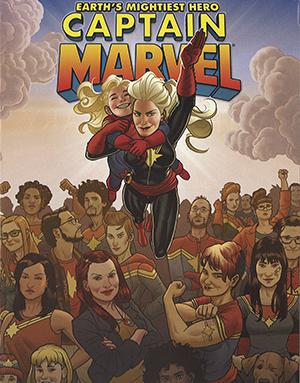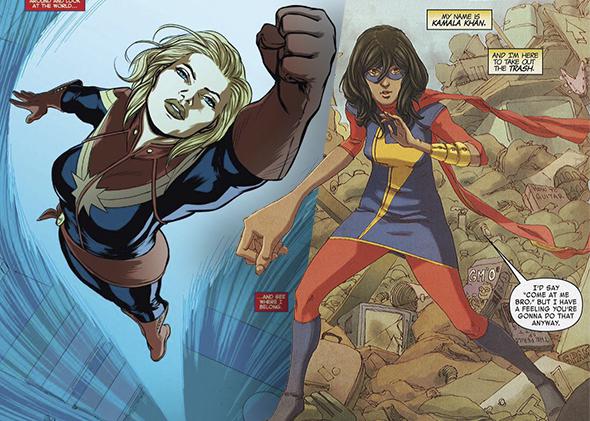When Marvel Comics announced that their newest superhero would be a Muslim teenager from New Jersey, the Pakistani-American girl Kamala Khan, the New York Times headline read like it could have come right out of the pages of the Daily Bugle: “Mighty, Muslim and Leaping Off the Page”! After only two issues, Ms. Marvel has indeed become quite mighty, garnering rave reviews from readers and critics and becoming a top-selling digital comic.
Written by G. Willow Wilson, Ms. Marvel uses Kamala’s shapeshifting superpowers to explore ideas of identity, faith, and coming-of-age. It’s not the first comic book to feature a Muslim superhero, but it’s captured the attention of readers because Kamala’s story is both compelling and imminently relatable. But Kamala Khan is only half the Ms. Marvel story. Comics readers coming to the new Ms. Marvel may not know that there’s another groundbreaking female superhero on the Marvel roster. The success, starting last year, of Captain Marvel—Carol Danvers, who preceded Kamala in the Ms. Marvel role for more than 30 years—helped blaze the trail for Kamala. Together, Carol and Kamala—the old and new Ms. Marvel—have become powerful figures in a nascent, but growing, movement to make superhero comics more diverse and widely appealing.
Carol Danvers first appeared as an ordinary Air Force officer in the Marvel universe in the late 1960s, and made her super-powered debut as Ms. Marvel in a solo series in 1977. An explosion caused her genes to meld with those of the alien superhero Captain Marvel, turning her into a human-alien hybrid with super-strength, physical near-invulnerability, and the power of flight. Ms. Marvel has been an enduring character in the Marvel universe, appearing in two solo series and as part of the Avengers and other Marvel teams. But even though Carol had some great storylines, Ms. Marvel was always drawn as the most stereotypically absurd female superhero: a blue-eyed blonde in a leotard, her long bare legs plunging into thigh-high superboots.
In July of 2012, Carol got a promotion, taking on the mantle of Captain Marvel in a new ongoing series written by Kelly Sue DeConnick. Fans of women in comics were glad to hear it, but everyone knew that female characters could never support their own solo series. The prevailing wisdom in comics has always been that any new solo series featuring a woman or a person of color is dead on arrival because the majority of comic book readers (white men, presumably) simply won’t buy it. It’s more complicated than that, of course, but new titles need to find a big audience very quickly in order to stay on shelves. Like many women who’ve been reading comics for a long time, I’ve found myself disappointed time after time by the cancellation of new and interesting female titles. If there’s a series coming up that a lot of women are excited about, it’s generally not been a good idea to get your hopes up about its long-term survival.
In the case of the new Captain Marvel, DeConnick herself admitted that she thought the series wouldn’t last. At the time, Captain Marvel was Marvel’s only solo series starring a female character. Even Black Widow, a central character in the Avengers film released just a few months before Captain Marvel hit shelves, hadn’t had her own comic book since 2010.

Courtesy of Marvel Comics
But the response to Captain Marvel was big, immediate, and passionate. The first issue sold out and got a second printing. A diverse and exuberant fan community, the Carol Corps, emerged almost overnight and began tweeting, blogging and cosplaying their love for both the character and DeConnick. (It’s worth noting that in addition to offering sharp writing and great stories, the new series let Carol trade her revealing leotard and domino mask for an actual body-covering uniform.) Captain Marvel attracted a lot of readers who were new to comics, and motivated a lot of women who had given up on comics to start reading again. And even though Captain Marvel was, by Marvel’s standards, only a small-scale hit, Marvel’s editorial team stood behind it: The series has been collected in two trade books, and Carol Danvers landed crucial roles in other Avengers titles, including becoming second-in-command behind Captain America in Marvel’s big 2013 Infinity crossover. Not only did Captain Marvel fans declare that she mattered to them, but Marvel made her matter to the whole Marvel universe.
Two years later, she’s poised to matter even more, thanks in part to the popular new character who owes a lot to her legacy. Captain Marvel relaunched with a new Issue No. 1 a few weeks ago, and now Carol is going cosmic: As the Avengers’ representative in space, she’ll be hanging out with the likes of the Guardians of the Galaxy (who are getting their big budget film adaptation this August) and protecting the Earth. Kevin Feige, president of production at Marvel Studios, recently confirmed that Captain Marvel has been considered as a possibility for its first standalone female superhero film.
Rather than deep-six one of its most enduring female characters after Carol’s promotion, Marvel went in a bold new direction in a comics industry that rarely promotes nonwhite superheroes. Enter Kamala Khan, a Jersey City teenager who is already negotiating a set of complex identities—first-generation American, Muslim, Jersey girl, nerd—even before she becomes a superhero. Kamala doesn’t feel like she can fit in because of her family and culture. She imagines how great it would be if she were like Captain Marvel, and even writes Avengers fan fiction online.
At the moment she gets her wish and acquires shapeshifting abilities, Kamala sees a vision of Carol, singing “Sakal Ban Phool Rahi Sarson” in Urdu. Kamala soon discovers that shapeshifting doesn’t make her life easier, but it gives her more power, more agency, and the ability to reflect on and create her sense of self. In a sense, this new Ms. Marvel is about the power of superhero stories themselves. While Carol Danvers is out protecting the Earth in space, she inspires Kamala Khan to make a difference to her family and community back home in Jersey City. (Hopefully, we’ll get to see Kamala go out in space sometime, too.)
From the day Ms. Marvel was announced, the Carol Corps, along with myriad writers, bloggers, and comic book readers, started spreading the word to buy Issue No. 1. Even before the first issue was published, there was already a Kamala Korps waiting to buy it. Ms. Marvel No. 1 sold out its first two printings, and the second issue has been a strong digital seller.
Where once the big two comics publishers were able to point to the perceived failures of titles featuring female superheroes or heroes of color, the commercial and critical success of these two comics changes the game. Even more heartening is the fact that both books feature a diverse cast of well-written characters, generally positive social messages, and nonabsurd costume choices. (Well, no more absurd than those of male superheroes.) These are books that dare to imagine that comic book readers represent a full spectrum of human beings. Because we do.

Courtesy of Marvel Comics
The devoted fans in the Carol Corps and Kamala Korps view themselves as part of a movement for a bigger and more diverse comic book universe, and it seems like publishers might finally be starting to pay attention. Both Ms. Marvel and the rebooted Captain Marvel are part of Marvel NOW!, an effort by the publisher to attract new readers by providing a lot of accessible places for new readers to jump on board with ongoing series. (DC Comics has done something similar with its New 52 initiative.) Marvel and DC have also taken some steps to address their lack of superhero diversity, in part by launching some new female solo titles, including Black Widow, She-Hulk, and Electra. Of course, there’s a whole world of mainstream and indie publishers beyond Marvel and DC, but the big two still matter the most because they create the pantheon of superheroes that make it into movie theatres and onto the racks of Halloween costumes at Target.
In Ms. Marvel Issue 2, Kamala uses her newfound shapeshifting abilities to save one of her peers from drowning, and also ends up being grounded for breaking curfew. (Such is the life of a teen superhero.) At end of the issue, Kamala starts to wonder why she has this power and what she can do with it. She turns to look at a poster in her room of Captain Marvel, striking the iconic Rosie the Riveter “We Can Do It” pose. Kamala strikes the same pose, her hand shapeshifting into a giant fist, and thinks, “Maybe this is what I’ve been waiting for. Maybe I’m finally part of something … bigger.”
Countless comic book readers, new and old, would agree: Captain Marvel and Ms. Marvel are exactly what we’ve been waiting for, and are a sign that perhaps we can finally be part of a bigger superhero universe. At least it’s worth getting our hopes up about it this time.
—
Captain Marvel, Vol. 1: In Pursuit of Flight and Vol. 2: Down. Marvel Comics.
Ms. Marvel. Marvel Comics.
See all the pieces in this month’s Slate Book Review.
Sign up for the Slate Book Review monthly newsletter.
